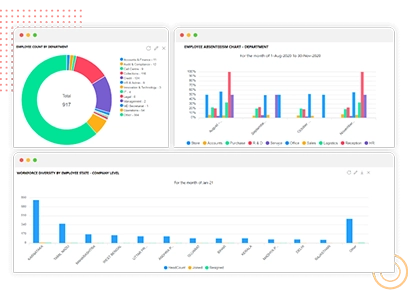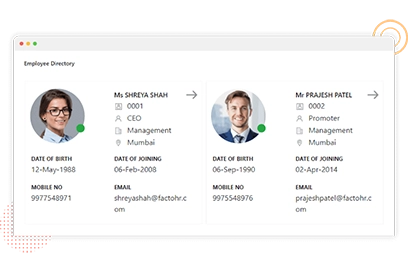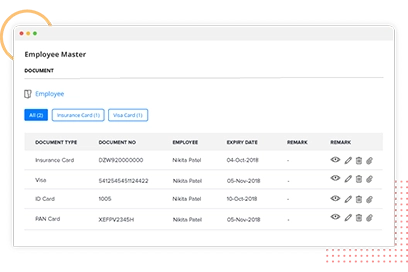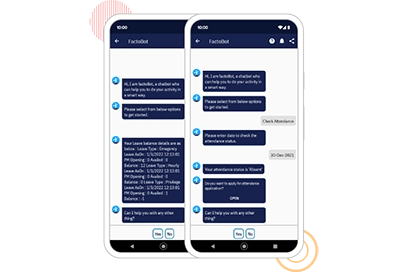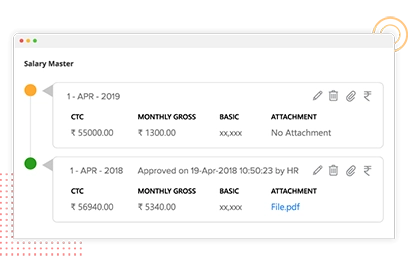Table of Contents
In the Philippines, the real estate, e-commerce, construction, tourism, BPO, and IT industries are thriving. Integrating an HRIS software into daily operations, along with efficient tools to manage employees, can make business management easier for owners and HR managers.
Whether a business is small or large, utilizing the right HR software can not only simplify HR tasks but also ensure legal compliance and promote employee engagement. To facilitate decision-making, here’s a list of the best HRIS system in the Philippines that can make managing HR simple and effective.
What is an HRIS?
An HRIS (Human Resource Information System) is software that helps organizations centralize their HR activities. It stores employee data, tracks attendance, manages payroll, and supports recruitment, performance, and compliance tasks.
An HR information system automates HR processes, helping to reduce manual work, save time, and prevent mistakes. It provides HR teams with accurate insights, improves decision-making, and streamlines communication between employees and management. An HRIS is a software solution that makes HR work faster, easier, and more efficiently.
10 Best HRIS System in Philippines Every Business Should Know
HRIS in the Philippines improves operations, efficiency, and employee engagement. This section presents our recommendations for the HRIS in the Philippines. We picked these solutions based on their functionality, usability, flexibility, cost-effectiveness, and customer happiness. We will highlight each software’s primary features, suitability, and cost.
1. factoHR
factoHR stands out as an all-in-one HRIS for Philippines, earning the top spot on our list. It helps automate and streamline all HR processes. It has all the modules and features that deliver efficiency and improve HR management. Companies benefit from its flexibility, security, and scalability.
factoHR is a comprehensive HR software solution that provides core features like employee onboarding, payroll management, attendance and leave management, and statutory compliance. It also offers essential functionality to manage performance, expenses, and retirement benefits. So, if you are in the market to simplify complex HR processes, factoHR should be your pick.
Features
| Dashboards for better, more intelligent analytics. | Onboarding Software to recruit new employees effortlessly. |
| Employee database management to centralize all your scattered employee data. | Document management to minimize paperwork and generate digital letters. |
| HR automation to simplify repetitive and administrative tasks. | The offboarding module will streamline the employee exit process. |
| With pre-defined templates, eliminate rework and auto-generate different letters. | Manage and solve employees’ queries using a chatbot. |
| An organizational tree that will help you create a clear reporting structure and define career paths. |
Pricing
TThe software’s price depends on the plan chosen. Businesses can contact factoHR for more details on the pricing plans.
Best Suited for
It can be used by all small to large firms to streamline their HR functions.

2. Sprout Solution
Sprout Solutions is the largest homegrown B2B SaaS company and the most trusted holistic HRIS platform. Local government and HR nuances are already built into their software. Their cloud-based platform automates and simplifies manual and complex HR processes, reducing time spent on admin work and eliminating common HR pain points across the employee lifecycle.
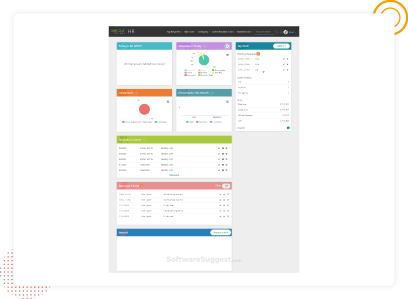
Features
- Payroll Management
- Mobile App
- Onboarding
- Analytics
- Data Visualization
Pricing
Pricing depends on the organizational needs. Contact the company for more details.
Best Suited for
It is suitable for all types of organizations.

3. GreatDay HR
Great DayHR is the most comprehensive HRIS and Payroll solution designed for businesses. You can say goodbye to tedious manual processes with GreatDay HR.
GreatDay HR’s secure, cloud-based solution can help you complete and automate routine administrative processes. Easy to implement for every employee, GreatDay HR simplifies your existing payroll process with automated payroll calculations. This ensures employees are always paid on time, regardless of cut-off periods.
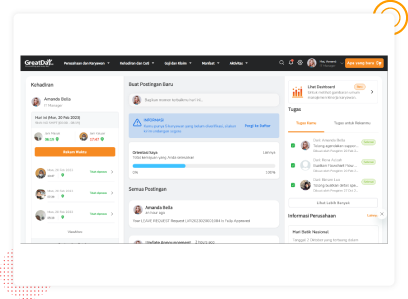
Features
- Payroll Management
- Performance Management
- Recruitment Management
- Employee Database
- Vacation / Leave Tracking
Pricing
Contact the company for the price details.
Best Suited for
It is used by all small to large organizations.

4. Deel
Deel is an HR management solution that helps thousands of companies expand globally with its unmatched speed and flexibility. It is a global hiring, HR, and payroll system merged into just one software. Deel claims to be the only HR Software with everything you need for everyone. They make global team management so easy that businesses do not need to worry about it. You can hire contractors and employees worldwide without opening legal entities, streamline HR for your global team, or consolidate payroll for everyone.
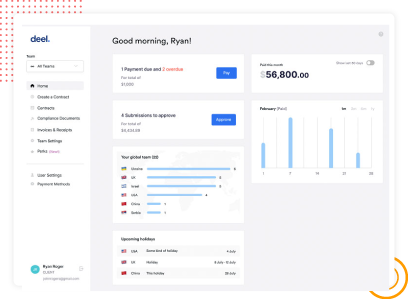
Features
- HR & Payroll
- Compliance Management
- Contract Management
- Compliance Reporting
- Analytical Reporting
Pricing
There are different plans ranging from $49 to $599
Best Suited for
It can be used by all organizations, from small to large.


5. PayrollPanda
PayrollPanda is part of the Jibble Group, which claims it is building the next world-class HR application through its two products, Jibble and PayrollPanda. PayrollPanda is an online payroll and HR solution, enabling business owners and HR managers to run LHDN-approved payroll while ensuring full compliance. It claims to make payroll so quick and straightforward that it is easy to use without prior training. In addition to payroll management, PayrollPanda comes with leave management and employee database management.
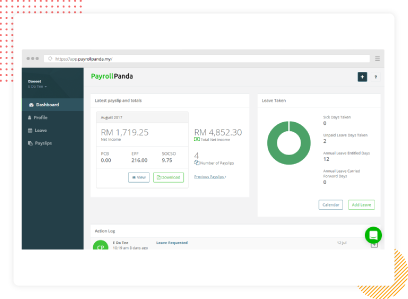
Features
- Employee Self-Service Management
- Expense Management
- Payroll Management
- Time & Attendance Management
- Compliance Management
Pricing
Pricing depends on the organizational needs. Contact the company for more details.
Best Suited for
Organizations of all sizes can use it.

6. PeoplesHR
PeoplesHR is one of the most trusted HR solutions in the HR industry. PeoplesHR brings different HCM solutions for organizations of various sizes. You get access to predictive and interactive analytics and enterprise dashboards with just a click for insightful decision-making. They provide a complete Human Capital Solution that improves the overall employee experience. You can experience the convenience of HCM on the go with their mobile app.
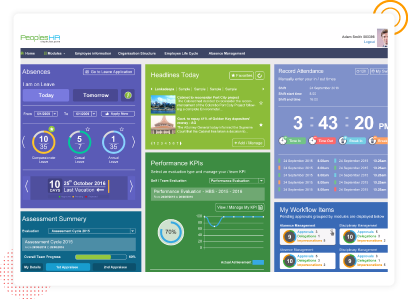
Features
- Core HR
- Time & Attendance
- Talent acquisition
- Payroll Management
- Employee Lifecycle Management
Pricing
Pricing depends on the organizational needs. Contact the company for more details.
Best Suited for
Organizations of all sizes can use it.
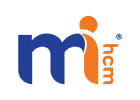
7. MiHCM
MiHCM can help transform employee potential into exceptional performance by using its complete cloud-based HCM solutions for HR management. The modern, user-friendly MiHCM is designed to enhance visibility into your workforce, develop your employees, source the best talent, and optimize the overall HR process. Their clients choose the intuitive cloud HR solution over traditional systems to accomplish their unique business needs. With a unified core HR and talent management system, MiHCM gives you a consistent overview of your workforce to make data-based decisions.
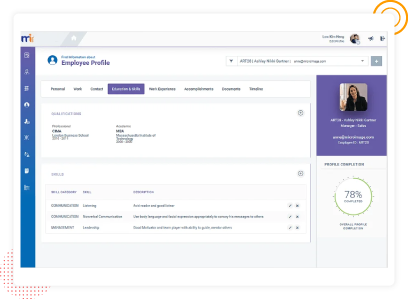
Features
- Leave & Absence Management
- Compensation & Benefits Management
- Data & Insights
- Hr & Payroll
- Workflow Management
Pricing
Businesses can contact the company for the price details.
Best Suited for
All sizes of organizations can use it.

8. Swingvy
Swingvy, a cloud-based HR software, makes it easy to onboard, pay, reimburse, track, and support your team. It brings people together with a company news feed and shared company calendar. Company information, an organization chart, and an employee directory are accessible to your team at any time, along with secure access to personal HR details, e-payslips, benefits allowance, leave balance, and leave and expense claim requests.
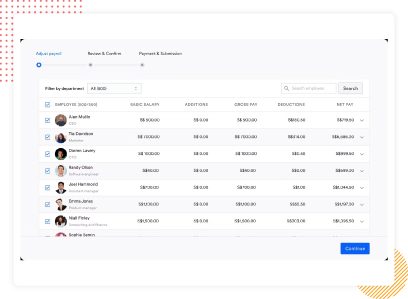
Features
- HR Management
- Leave Management
- Expense Claims Management
- Payroll Management
- Organization Chart
Pricing
It starts from $2.55 and ranges up to $4.25.
Best Suited for
All sizes of organizations can use it.


9. PayrollHero
PayrollHero is a cloud-based time, scheduling, attendance, HRIS, and payroll system. It eliminates punch clocks, allowing employees to clock in with facial recognition and geolocation. It enables employees to view their schedules at home or work, so they know what is expected of them. Live company leaderboards would allow employees to be punctual and motivated by comparing their performances against those of coworkers. Managers can edit schedules on the go with TeamClock, while approvals for overtime and leave follow company workflows. This software supports analytics and reporting, giving employers valuable insights for informed decision-making.
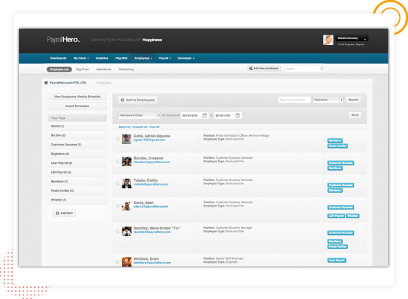
Features
- Time and Attendance
- Payroll
- Leave Management
- Employee Profiles
- Analytics
Pricing
The HRIS, Timekeeping, Attendance, and Scheduling module plan starts at US $3.50 per employee/month, with additional add-ons available
Best Suited for
It is suitable for all types of organizations.

10. HRMS PRO
Mustard Seed Systems Corporation, which offers HRMS Pro, is an HR solution for small and medium enterprises (SMEs). Effortlessly manage your payroll from anywhere, anytime, with our cloud-based HR payroll solutions that provide unparalleled convenience, security, and scalability. With a comprehensive suite of tools and services, you can be confident that your business constantly evolves to keep pace with the changing times.
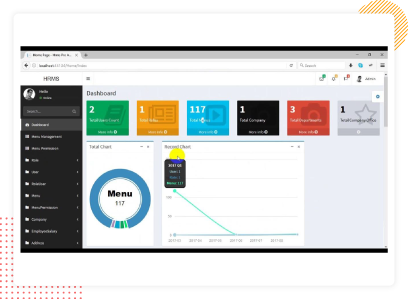
Features
- Complete HR Management
- Automated Payroll Process
- Modern Leave & Payroll Management System
- Integrated Timekeeping & Attendance
- Self-Service Kiosk
Pricing
Price plans are customizable. Contact the company for more details.
Best Suited for
All types of organizations can use it.

Find out What the Best HR Software in the Philippines
| Must-Have Features of the Best HRIS System in the Philippines | Rating | |||||||
|---|---|---|---|---|---|---|---|---|
| Software | Biometric | Real‑Time Attendance | Mobile Access | Performance Reviews | Expense MGMT | G2 | Capterra | |
| factoHR | 4.6 | 4.7 | ||||||
| Sprout Solutions | 4.7 | 4.7 | ||||||
| GreatDay HR | 3.3 | N/A | ||||||
| Deel | 4.8 | 4.8 | ||||||
| PayrollPanda | 4.8 | 3.8 | ||||||
| PeoplesHR | 4.4 | 4.5 | ||||||
| MiHCM | 4.8 | 3.8 | ||||||
| Swingvy | N/A | N/A | ||||||
| PayrollHero | 4.2 | 4.4 | ||||||
| HRMS PRO | N/A | N/A | ||||||
Key Features to Look for in an HRIS Philippines
Payroll & Benefits Automation
A top HRIS in the Philippines must automate salary calculations, deductions, contributions, and benefits. The system should accurately handle SSS, Pag-IBIG deductions, and PhilHealth, prepare tax reports, and generate digital payslips.
Automated payroll ensures employees are paid correctly and on time, while minimizing errors that often occur with manual processing. It also helps HR teams save hours every month, allowing them to focus on more critical tasks.
Time & Attendance Tracking
An HRIS that monitors employee hours with digital tools can significantly improve productivity. Features like biometric attendance, mobile clock-ins, geo-fencing for remote staff, and shift scheduling ensure accurate timekeeping. These records directly feed into payroll, reducing time theft and disputes while giving managers visibility into employee attendance and work locations.
Leave Management
Leave requests, approvals, and balance tracking should be transparent and straightforward. An HRIS enables employees to apply for leave online, notifies managers instantly, and automatically updates leave balances.
The software should also support company-specific rules, like leave accrual, encashment, carryover, and holiday calendars. This eliminates paperwork and creates a transparent, efficient process for both HR and employees.
Legal & Regulatory Compliance
The selected HRIS in the Philippines must strictly follow local labor regulations. This includes accurately handling SSS contributions, PhilHealth coverage, Pag-IBIG membership, and tax reporting requirements.
The software should include a built-in compliance feature to help prevent payroll challenges, facilitate the smooth filing of reports, and protect businesses from legal penalties or fines. This is especially critical for growing companies managing a larger workforce.
Employee Self-Service (ESS) Portal
Managing employees is a continuous task, which involves handling leave requests, sending reminders, and processing payroll. A cloud-based employee self-service portal and a mobile app should accompany a robust HRIS.
This allows employees to view payslips, apply for leave, submit expense claims, and update personal details from anywhere. For HR teams, this reduces repetitive queries and enhances staff engagement in managing their own data.
Reporting, Analytics & Audit Trails
An HRIS should provide powerful HR reporting features that give managers real-time insights into workforce data. Dashboards and analytics can reveal patterns such as turnover rates, absenteeism, and labor costs, facilitating more informed decision-making. Audit trails are also important; they track every change made in the system, ensuring transparency and accountability during reviews or compliance checks.
Centralized Employee Data & Document Management
An HRIS in the Philippines must store all employee information securely in one place. From contracts and government IDs to certifications and performance records, information should be well-organized and easily retrievable.
Digital document management reduces reliance on paper, allows version control, and ensures sensitive files are accessible only to authorized staff. This also speeds up audits and compliance checks.
Security & Data Privacy
Protecting sensitive employee information is a top priority. A reliable human resource information system in the Philippines should employ robust security measures, including role-based access controls, encryption, secure backups, and adherence to Philippine data privacy laws. This ensures that payroll data, personal records, and company information remain safe and confidential at all times.
Ease of Use/Mobile Access
Usability issues often cause delays, confusion, and errors. The best HRIS system is easy for everyone in the organization to use, whether they’re HR staff, managers, or employees.
A clean interface, smooth data migration, and reliable support reduce training time and prevent frustration. Mobile access makes the system even more convenient, allowing employees and HR teams to perform tasks on the go.
Multi-Language and Local Usability
With the Philippines’ diverse culture and languages, an HRIS must be designed to meet local needs. Multi-language support, including Tagalog, ensures employees can access information in the language they are most comfortable with. Mobile accessibility, localized training materials, and language-based notifications improve clarity, reduce misunderstandings, and strengthen employee engagement.
Scalability & Customization
An HRIS should scale with the business as it grows. The system must allow the addition of new users, branches, or modules without difficulty. Customization is equally essential; companies should be able to set their own approval workflows, rules, and fields to reflect unique processes. This ensures the software continues to meet business needs as the organization expands.
Integration Capabilities
To create a seamless HR ecosystem, the HRIS must integrate with payroll systems, banking systems, accounting systems, ERP software, and other third-party applications. This reduces duplicate data entry, ensures information flows smoothly across departments, and saves time. Strong integration capabilities also allow businesses to connect HR data with financial and operational systems for more detailed insights.
Conclusion
When selecting an HRIS system in the Philippines, ensure the system covers your primary, local labor laws, regulations, and comprehensive HR requirements. Before you choose a platform, examine your organization’s size, culture, and maturity. Following that, you may create a list of all the features and procedures that are crucial to your organization. Then, seek HR software in the Philippines that meets your requirements.
We understand how challenging it can be to achieve your HRM objectives while maintaining operational efficiency. But do not be afraid! We are here to assist. factoHR’s core HR module consolidates HR processes, automates standard procedures, and provides comprehensive capabilities for performance management, time tracking, and compliance, all in one spot.
FAQs
What is the Difference between HRIS and HRMS?
An HRIS (Human Resource Information System) is mainly used to store employee information and manage payroll, attendance, and compliance tasks. An HRMS (Human Resource Management System) includes all HRIS functions but also adds broader tools, like performance management, recruitment, and employee development.
Why is factoHR Considered the Best HRIS in the Philippines?
factoHR is highly rated because it combines automation, strong compliance with Philippine labor laws, and easy scalability. It covers all HR needs in one platform, such as payroll, attendance, leave, and performance, making HR work faster and more efficiently for local businesses.
Can an HRIS Integrate with Philippine Government Agencies?
Yes. Modern HRIS platforms can integrate with government systems, such as SSS, PhilHealth, and Pag-IBIG. This makes contributions, tax filings, and compliance reporting much easier and reduces manual work.
How does an HRIS in the Philippines Benefit Both HR Teams and Employees?
For HR teams, it automates daily tasks, minimizes errors, and gives accurate insights through reports. For employees, it provides self-service options, such as checking payslips, submitting leave or expense requests, and updating personal data, anytime through web or mobile apps.
Does an HRIS System Help in Generating Philippine Government-Mandated Reports?
Yes. HRIS platforms can automatically generate all required reports for tax, SSS, PhilHealth, and Pag-IBIG. This ensures companies remain compliant with Philippine laws and avoid delays or penalties.
© 2025 Copyright factoHR


